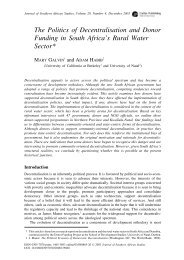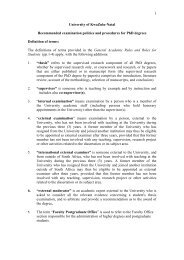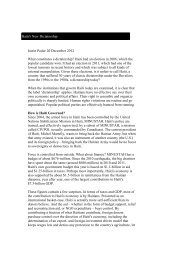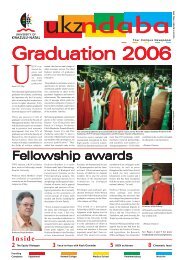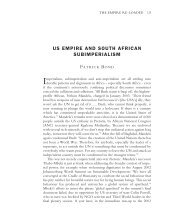Land Reform in South Africa: An Overview - Centre for Civil Society
Land Reform in South Africa: An Overview - Centre for Civil Society
Land Reform in South Africa: An Overview - Centre for Civil Society
You also want an ePaper? Increase the reach of your titles
YUMPU automatically turns print PDFs into web optimized ePapers that Google loves.
<strong>Land</strong> <strong>Re<strong>for</strong>m</strong> <strong>in</strong> <strong>South</strong> <strong>Africa</strong>: <strong>An</strong> <strong>Overview</strong>32 Int’l J. Legal Info. 283 (2004)Sam RugegeINTRODUCTION: THE NEED FOR LAND REFORM<strong>South</strong> <strong>Africa</strong> suffered a long history of colonization, racial dom<strong>in</strong>ation and land dispossession thatresulted <strong>in</strong> the bulk of the agricultural land be<strong>in</strong>g owned by a white m<strong>in</strong>ority. Black people resistedbe<strong>in</strong>g dispossessed but were defeated by the superior arms of the newcomers. As Lew<strong>in</strong> haswritten, "whatever m<strong>in</strong>or causes there may have been <strong>for</strong> the many Bantu-European wars, thedesire <strong>for</strong> land was the fundamental cause." [FN1] Despite the claims that <strong>South</strong> <strong>Africa</strong> was largelyun<strong>in</strong>habited at the time of the arrival of Europeans, documentary evidence shows that <strong>in</strong> fact theland was <strong>in</strong>habited. Thus the journal of the first European to settle at the Cape, Jan van Riebeeckrecords <strong>in</strong>cidents of confrontation with the <strong>in</strong>digenous Khoi-khoi (or Hottentots) <strong>in</strong> 1655.Only last night it happened that about 50 of these natives wanted to put up their huts close to thebanks of the moat of our <strong>for</strong>tress, and when told <strong>in</strong> a friendly manner by our men to go a little furtheraway, they declared boldly that this was not our land but theirs and that they would place their hutswherever they chose. If we were not disposed to permit them to do that *284 they would attack uswith the aid of a large number of people from the <strong>in</strong>terior and kill us. [FN2]Documents compiled by the historians Davenport and Hunt show how the <strong>in</strong>digenous San peoplewere almost exterm<strong>in</strong>ated by the advanc<strong>in</strong>g white farmers and how despite their resistance theother <strong>Africa</strong>n tribes lost the land either through wars or were cajoled <strong>in</strong>to giv<strong>in</strong>g up the land throughagreements which they did not understand. [FN3] The colonial and apartheid state conf<strong>in</strong>ed the<strong>in</strong>digenous <strong>Africa</strong>n people to reserves consist<strong>in</strong>g largely of barren land or areas with poor ra<strong>in</strong>fallpatterns while the more fertile land was allocated to white farmers <strong>for</strong> commercial agriculture.Although dispossession of black people <strong>in</strong>itially took place through conquest and trickery, it cameto be a major policy of the state supported by an array of laws from the early days of colonization.The most systematic land dispossession by the state came <strong>in</strong>to effect after 1913. The Native <strong>Land</strong>Act of 1913 [FN4] apportioned 8% of the land area of <strong>South</strong> <strong>Africa</strong> as reserves <strong>for</strong> the <strong>Africa</strong>ns andexcluded them from the rest of the country, which was made available to the white m<strong>in</strong>oritypopulation. <strong>Land</strong> available <strong>for</strong> use by <strong>Africa</strong>ns was <strong>in</strong>creased by 5% <strong>in</strong> 1936 [FN5] br<strong>in</strong>g<strong>in</strong>g the totalto 13% of the total area of <strong>South</strong> <strong>Africa</strong>, although much of the land rema<strong>in</strong>ed <strong>in</strong> the ownership of thestate through the <strong>South</strong> <strong>Africa</strong>n Development Trust supposedly held <strong>in</strong> trust <strong>for</strong> the <strong>Africa</strong>n people.Thus 80% of the population was conf<strong>in</strong>ed to 13% of the land while less than 20% owned over 80%of the land. Black people were prohibited from buy<strong>in</strong>g land <strong>in</strong> areas outside the reserves. Thisapportionment of land rema<strong>in</strong>ed until the end of apartheid <strong>in</strong> early 1990s and rema<strong>in</strong>s virtuallyunchanged. The ma<strong>in</strong> purposes of the <strong>Land</strong> Act 1913 were firstly to make more land available towhite farmers. Secondly, it was to impoverish black people through dispossession and prohibitionof <strong>for</strong>ms of farm<strong>in</strong>g arrangements that permitted *285 some self-sufficiency. This meant theybecame dependent on employment <strong>for</strong> survival, thus creat<strong>in</strong>g a pool of cheap labor <strong>for</strong> the whitefarms and the m<strong>in</strong>es. [FN6] White farmers had repeatedly compla<strong>in</strong>ed that black people refused towork <strong>for</strong> them as servants and laborers. Thirdly, there was of course also the purpose of en<strong>for</strong>c<strong>in</strong>gpage 1 of 28
the policy of racial segregation, which had previously not been consistently en<strong>for</strong>ced. Besidesimpoverish<strong>in</strong>g black people and stunt<strong>in</strong>g their economic development, the successive whitegovernments caused a lot of suffer<strong>in</strong>g, humiliation and abuse of the human rights of black people.The migrant system that resulted from the need of black males to migrate to the cities and whitefarms <strong>in</strong> order to earn a liv<strong>in</strong>g and provide <strong>for</strong> their families, <strong>in</strong> many cases resulted <strong>in</strong> the break upof families and dislocation of social life.The Group Areas Act of 1950, [FN7] passed soon after the National Party took over government <strong>in</strong>1948, was used by the apartheid state to carry out <strong>for</strong>ced removals of black people from landdeclared to be white areas and to complete the policy of racial segregation by remov<strong>in</strong>g "coloured"and Indian people from so-called white areas. Pockets of black farmers who had escaped the1913 <strong>Land</strong> Act because they had title deeds to their land, were removed under the Group Areas Act<strong>in</strong> a process that was dabbed clean<strong>in</strong>g up the "black spots." The "black spots" were usually fertileland whereas the areas <strong>in</strong> the Bantustans where the people were moved to were over-crowded,over-grazed and over-cultivated. The Prevention of Illegal Squatt<strong>in</strong>g Act of 1951 augmented theGroup Areas Act and other racially based land laws by mak<strong>in</strong>g provision <strong>for</strong> the eviction of peoplewho had no <strong>for</strong>mal rights on land. It authorized the state and private landowners to evict people anddemolish their homes without court orders. In effect, most of those evicted had <strong>in</strong>itially lived on theland with the consent of the owner but once that consent was withdrawn <strong>for</strong> whatever reason, thepeople automatically became classified as squatters and became liable to be evicted. [FN8] Thoseremoved were damped <strong>in</strong> the crowded Bantustans or homelands or moved on to other vacant landuntil the land was needed <strong>for</strong> another purpose *286 prompt<strong>in</strong>g their eviction aga<strong>in</strong>. It is estimatedthat 3.5 million people were <strong>for</strong>cibly removed under various apartheid laws between 1960 and1983. [FN9]The struggle <strong>for</strong> liberation from colonial and apartheid dom<strong>in</strong>ation was partly based on theobjective of rega<strong>in</strong><strong>in</strong>g the land. The sentiments beh<strong>in</strong>d this struggle can be summarized <strong>in</strong> thestatement by an old man at a community meet<strong>in</strong>g:The land, our purpose is the land, that is what we must achieve. The land is our whole lives, weplough it <strong>for</strong> food, we build our houses from the soil, we live on it and we are buried <strong>in</strong> it. When thewhites took our land away from us we lost the dignity of our lives, we could no longer feed ourchildren. We were <strong>for</strong>ced to become servants, we were treated like animals. Our people have manyproblems, we are beaten and killed by the farmers, the wages we earn are too little to buy even abag of mielie-meal. We must unite together to help each other and face the Boers. But <strong>in</strong> everyth<strong>in</strong>gwe do we must remember that there is only one aim and one solution and that is the land, the soil,our world. [FN10]The Freedom Charter of 1955 set the goal of shar<strong>in</strong>g the land: "Restriction on land ownership shallbe ended, and all the land redivided among those who work it, to banish fam<strong>in</strong>e and hunger...Allshall have the right to occupy land wherever they choose.." [FN11]Liberation and democracy were ultimately not won through armed struggle but through anegotiated settlement, which necessitated compromises on the issue of land. Whereas the hopesof the black people were that after apartheid they would rega<strong>in</strong> the land or that at least everyonewould ga<strong>in</strong> access to enough land <strong>for</strong> her or his needs, the negotiated settlement left thedistribution of land largely unchanged through the constitutional guarantee of the right to *287property with only a limited <strong>for</strong>m of restitution. Nevertheless, it was the policy of the <strong>in</strong>com<strong>in</strong>ggovernment of the <strong>Africa</strong>n National Congress (ANC) to effect land re<strong>for</strong>m that would to a significantextent ameliorate the <strong>in</strong>justices of deprivation and denial of access to land. <strong>Land</strong> re<strong>for</strong>m would alsopage 2 of 28
alleviate poverty, especially <strong>in</strong> the rural areas, and give some protection aga<strong>in</strong>st eviction to thosewho had been <strong>for</strong>ced <strong>for</strong> generations to live on land without proper rights. In the policy document,the Reconstruction and Development Programme (RDP), the ANC undertook to carry out landre<strong>for</strong>m under three major strategies: restitution to restore land rights to those who weredispossessed of them under discrim<strong>in</strong>atory laws, redistribution to make land more accessible tothose who had previously been denied access, and tenure re<strong>for</strong>m to give security of tenure to labortenants, farm workers and other rural dwellers who lived on land without secure rights. [FN12]THE CONSTITUTIONThe Interim Constitution of 1993, which ushered <strong>in</strong> the new democratic era <strong>in</strong> <strong>South</strong> <strong>Africa</strong>, did notconta<strong>in</strong> detailed provisions <strong>for</strong> land re<strong>for</strong>m. It was a compromise negotiated between the ma<strong>in</strong><strong>in</strong>terest groups <strong>in</strong> the negotiat<strong>in</strong>g process, the <strong>Africa</strong>n National Congress and its allies, on the onehand, and the National Party government and its allies on the other. The issue of the <strong>in</strong>clusionof property rights <strong>in</strong> the Constitution was highly contested. Some <strong>in</strong> the liberation movementsargued aga<strong>in</strong>st a property clause that would guarantee the exist<strong>in</strong>g property rights on the groundthat this would hamper ef<strong>for</strong>ts by the democratic government to carry out programs of land re<strong>for</strong>m. Itwas also argued "to entrench exist<strong>in</strong>g property rights <strong>in</strong> the new <strong>South</strong> <strong>Africa</strong>n Constitution was tolegitimize and entrench, as a human right, the consequences of generations of apartheid anddispossession." [FN13] On the other hand, the government of the day and its supporters arguedstrongly <strong>for</strong> the <strong>in</strong>clusion of such a clause to ensure land would not be nationalized and transferredto the land-hungry majority without compensation to current owners. Ultimately, all parties agreedto *288 <strong>in</strong>clude a property clause <strong>in</strong> the Bill of Rights. However, there were no specific provisions<strong>for</strong> a comprehensive program of land re<strong>for</strong>m. The only provision was <strong>in</strong> relation to the right torestitution of land rights <strong>for</strong> persons or communities dispossessed of such rights underdiscrim<strong>in</strong>atory laws. [FN14]The 1996 Constitution, drafted by a democratically elected Constitutional Assembly, was morespecific about land re<strong>for</strong>m and more balanced <strong>in</strong> address<strong>in</strong>g the issue of property. <strong>Land</strong> matterswere treated as matters of rights and <strong>in</strong>cluded <strong>in</strong> the Bill of Rights. Section 25 of the Constitutionguarantees the right of property aga<strong>in</strong>st arbitrary deprivation but also provides <strong>for</strong> thepower of the state to expropriate private property <strong>for</strong> public purposes or <strong>in</strong> the public <strong>in</strong>terest subjectto just and equitable compensation. Public <strong>in</strong>terest is specifically def<strong>in</strong>ed to <strong>in</strong>clude "the nation'scommitment to land re<strong>for</strong>m, and to re<strong>for</strong>ms to br<strong>in</strong>g about equitable access to all <strong>South</strong> <strong>Africa</strong>'snatural resources..." [FN15] The amount recoverable as compensation <strong>in</strong> case of expropriation, issubject to certa<strong>in</strong> considerations which may have the effect of reduc<strong>in</strong>g it considerably below themarket value but which ensure that it is just <strong>in</strong> the circumstances. Section 25(3) states: Theamount, tim<strong>in</strong>g, and manner of payment of compensation must be just and equitable, reflect<strong>in</strong>g anequitable balance between the public <strong>in</strong>terest and the <strong>in</strong>terests of those affected, hav<strong>in</strong>g regard toall relevant factors, <strong>in</strong>clud<strong>in</strong>g: (a) the current use of the property;(b) the history of the acquisition and use of the property; (c) the market value of the property; (d) theextent of direct state <strong>in</strong>vestment and subsidy <strong>in</strong> the acquisition and beneficial capital improvementsof the property; and (e) the purpose of the expropriation.At the same time, the property clause <strong>in</strong>cludes specific provisions on land re<strong>for</strong>m, which imposeobligations on the state to br<strong>in</strong>g about greater access to land. These provisions embody threepage 3 of 28
different aspects of enhanc<strong>in</strong>g access to land: restitution, redistribution and tenure re<strong>for</strong>m asorig<strong>in</strong>ally conceptualized <strong>in</strong> the RDP. In what follows, an attempt is made to summarize the *289Constitutional and statutory provisions of these strategies as well as their implementation.RESTITUTIONThe Legal ProvisionsThe Constitution provides that persons or communities who were dispossessed of property after19 June 1913 [the date of the com<strong>in</strong>g <strong>in</strong>to effect of the notorious Native <strong>Land</strong> Act of 1913] as a resultof past racially discrim<strong>in</strong>atory laws or practices are entitled <strong>in</strong> terms of an Act of Parliament torestoration of that property or to equitable redress. [FN16]The Act of Parliament giv<strong>in</strong>g effect to the constitutional provision is the Restitution of <strong>Land</strong> RightsAct. [FN17] The Act entitles a person or a community dispossessed of rights <strong>in</strong> land or adescendant of a person or a deceased estate of a person dispossessed of rights <strong>in</strong> land, after 19June 1913, as a result of racially discrim<strong>in</strong>atory laws or practices, to claim restoration of thoserights or equitable relief such as alternative land or compensation. [FN18] The scope of restitutionand its potential <strong>for</strong> trans<strong>for</strong>m<strong>in</strong>g the distribution of land ownership <strong>in</strong> <strong>South</strong> <strong>Africa</strong> is limitedbecause of its 1913 cut off date which excludes many potential claimants who were dispossessedof land be<strong>for</strong>e 1913. The cut-off date was a compromise agreed to by those who negotiated thenew dispensation on the basis that leav<strong>in</strong>g the right to restitution open-ended would have entailedmany problems. As stated <strong>in</strong> the White paper on <strong>Land</strong> Policy: "In <strong>South</strong> <strong>Africa</strong>, ancestral land claimscould create a number of problems and legal-political complexities that would be difficult tounravel." [FN19] This conclusion was reached based on various grounds. Firstly, s<strong>in</strong>ce mosthistorical claims are based on membership of a tribal k<strong>in</strong>gdom or chiefdom "the enterta<strong>in</strong>ment ofsuch claims would serve to awaken and/or prolong ethnic and racial politics." Secondly, it would bedifficult to determ<strong>in</strong>e the eligible claimants as members of ethnic communities or chiefdoms andtheir descendants had <strong>in</strong>creased more than eight times and were scattered. Thirdly, large parts of<strong>South</strong> <strong>Africa</strong> could be subject *290 of overlapp<strong>in</strong>g and compet<strong>in</strong>g claims where pieces of land hadbeen occupied <strong>in</strong> succession by different groups, <strong>for</strong> example, the San, Khoi, Xhosa, Mfengu,Trekkers and British. [FN20] It is doubtful that the white m<strong>in</strong>ority, represented by the National Partygovernment would have agreed to an open-ended restitution claims process know<strong>in</strong>g that virtuallythe whole of the <strong>South</strong> <strong>Africa</strong>n land surface could be the subject of restitution claims. Nevertheless,many black <strong>South</strong> <strong>Africa</strong>ns are to-date unhappy about the cut-off date, [FN21] although it is difficultto imag<strong>in</strong>e how the process would have worked without the cut-off date.In the <strong>in</strong>terest of certa<strong>in</strong>ty <strong>for</strong> exist<strong>in</strong>g landowners, a deadl<strong>in</strong>e of 31 December 1998 was alsoimposed by the Act <strong>for</strong> the lodgment of claims. This also has excluded some potential claimantswho did not get to know that they had a right to restitution <strong>in</strong> good time [FN22] or be<strong>in</strong>g under thepatronage of the land owners as labor tenants or farm workers, were afraid to lodge their claims.The Commission <strong>for</strong> Restitution of <strong>Land</strong> Rights (CRLR) has acknowledged the problem but hasrejected calls <strong>for</strong> the reopen<strong>in</strong>g of the lodg<strong>in</strong>g of claims. It has stated: It appears that there aremany people who did not lodge their claims probably because they did not believe that thisrestitution promise would be met. Now that they see that claims are be<strong>in</strong>g settled, they are putt<strong>in</strong>gpressure on the Commission to re-open the lodgment process. The Commission isunable to do so, s<strong>in</strong>ce it is bound by the Act. [FN23]The Commission gives examples of areas where calls <strong>for</strong> reopen<strong>in</strong>g have been made: District Sixpage 4 of 28
<strong>in</strong> the Western Cape (Cape Town), rural betterment claims <strong>in</strong> the Eastern Cape (<strong>for</strong>mer Transkei &Ciskei) and urban claims <strong>in</strong> Uitenhage and Kirkwood.*291 Progress <strong>in</strong> ImplementationAccord<strong>in</strong>g to the White Paper, the government had set itself targets <strong>for</strong> the f<strong>in</strong>alization of restitutionas follows: "a three year period <strong>for</strong> the lodgment of claims, from 1 May 1995; a five year period <strong>for</strong>the Commission and the Court to f<strong>in</strong>alize all claims; and a ten year period <strong>for</strong> the implementation ofall court orders." [FN24] The program is now <strong>in</strong> its n<strong>in</strong>th year and should there<strong>for</strong>e be completed bynext year (2005). However, the process has not moved at the pace envisaged. The validation ofclaims, that is, the <strong>in</strong>vestigation to determ<strong>in</strong>e whether a claim is prima facie valid <strong>in</strong> terms of thecriteria set by section 2 of the Act, has been completed but the verification process-confirm<strong>in</strong>g theidentities of claimants, the size and value of the land <strong>in</strong>volved etc. is still go<strong>in</strong>g on and thesettlement of claims is far from be<strong>in</strong>g completed. However, the rate of settlement of claims hasgreatly <strong>in</strong>creased over the years. Whereas <strong>in</strong> the four years between 1996 and 1999 only 41 claimshad been settled, benefitt<strong>in</strong>g 3,508 households, <strong>in</strong> the follow<strong>in</strong>g four years 36, 645 claims weresettled (about half of the total number of claims) benefitt<strong>in</strong>g 80, 153 households. [FN25] Accord<strong>in</strong>gto the latest statistics issued by the <strong>Land</strong> Claims Commission, as of February 2004, 48 663 or61% of all claims have been settled, benefitt<strong>in</strong>g 117 326 households. [FN26] This is aconsiderable achievement given the challenges that the Commission has been fac<strong>in</strong>g.Nevertheless, it is unlikely that the target of complet<strong>in</strong>g the process <strong>in</strong>clud<strong>in</strong>g implementation ofsettlement awards by 2005 can be atta<strong>in</strong>ed. President Mbeki <strong>in</strong> 2002 called on the Commission tocomplete the process of settl<strong>in</strong>g all claims by 2005. This does not mean implementation of wardsmust be completed by that time. However, even the reach<strong>in</strong>g of settlement agreements or obta<strong>in</strong><strong>in</strong>gcourt orders <strong>in</strong> respect of all the claims may not be achieved by the target date. [FN27]The Commission faces a number of challenges that may make the achievement of the 2005 targetimpossible. First it lacks the capacity <strong>in</strong> its various offices to handle all the stages of process<strong>in</strong>gclaims, especially verification, valuation of claims and calculation of compensation to be paid eitherto claimants or to owners of land under claim. Secondly, there are problems with obta<strong>in</strong><strong>in</strong>g thenecessary evidence, documentary or otherwise to *292 go ahead with a claim that is prima-facievalid. Many of the land rights <strong>in</strong> rural areas were never registered or surveyed. Some claimants donot have identity documents, marriage or death certificates which can assist with proof ofentitlement to restitution. Thirdly, many current owners of land are reluctant to give up the land orare outright hostile to restitution. Some landowners' organizations have een wag<strong>in</strong>g a campaignurg<strong>in</strong>g their members not to cooperate <strong>in</strong> the restitution process. The Transvaal Agricultural Union,<strong>for</strong> <strong>in</strong>stance, has set up a Restitution Resistance Fund <strong>in</strong>tended to raise money to pay off claimantsso they withdraw their claims or settle <strong>for</strong> less valuable land elsewhere. Where farmers haveagreed to negotiate <strong>for</strong> the purchase of the land <strong>for</strong> restitution, they have pitched p the prices of theland out of the reach of the state, sometimes up to 10 times or more the market value. [FN28] Thestate has the power under the Constitution to expropriate the land subject to payment of "just andequitable" compensation. However, <strong>in</strong> the <strong>in</strong>terest of reconciliation and national unity as well as thedesire to portray <strong>South</strong> <strong>Africa</strong> as an <strong>in</strong>vestor-friendly country that protects private property, thegovernment has from the start been reluctant to resort to expropriation. It has preferred to negotiateand follow the pr<strong>in</strong>ciple of "will<strong>in</strong>g buyer will<strong>in</strong>g seller." Given the unreasonableness of somefarmers, owever, there is no reason why the government should not go <strong>for</strong> expropriation. Thiswould not only accelerate the rate of settl<strong>in</strong>g claims but would act as an <strong>in</strong>centive to land owners totake the state more seriously and encourage them to demand reasonable prices. <strong>An</strong> amendmentpage 5 of 28
to the Restitution of <strong>Land</strong> Rights Act [FN29] has been passed giv<strong>in</strong>g the M<strong>in</strong>ister the power toexpropriate land <strong>for</strong> restitution without hav<strong>in</strong>g to get a court order. Previously, the Act provided <strong>for</strong>expropriation of land <strong>for</strong> restitution where the <strong>Land</strong> Claims Court had ordered the state toexpropriate land <strong>for</strong> the purpose. Although noth<strong>in</strong>g stopped the state expropriat<strong>in</strong>g <strong>in</strong> terms ofsection 25(2) of the Constitution, the Amendment Act makes the matter much clearer. TheAmendment should <strong>in</strong>deed allow the acquisition of land to proceed much faster where thelandowner is refus<strong>in</strong>g to negotiate. There is still scope <strong>for</strong> landowners to frustrate the process bychalleng<strong>in</strong>g the amount offered as compensation <strong>in</strong> the <strong>Land</strong> Claims Court. However, s<strong>in</strong>ce theexpropriation *293 becomes effective at the time of a valid expropriation order by the M<strong>in</strong>ister, theAmendment still takes the process <strong>for</strong>ward. What rema<strong>in</strong>s is to see whether the state is seriousabout expropriation and has the political will to proceed or whether it is only a threat to get thelandowners talk<strong>in</strong>g. What is necessary is a few expropriations to send a clear message to whitefarmers that government is serious. Be<strong>for</strong>e the "fast-track" land acquisition <strong>in</strong> Zimbabwe got out ofhand, this k<strong>in</strong>d of strategy had worked <strong>in</strong> gett<strong>in</strong>g farmers talk<strong>in</strong>g and negotiat<strong>in</strong>g seriously with thestate.Fourthly, there is the problem of f<strong>in</strong>anc<strong>in</strong>g the program. Although the state has already spent overthree billion rand on restitution, the Commission requires more billions to pay <strong>for</strong> land, providecompensation but also to pay <strong>for</strong> the consultants that assist the commission <strong>in</strong> validat<strong>in</strong>g theclaims and carry<strong>in</strong>g out the valuations of claims and the land. Given the other priorities of the statesuch as education, health and hous<strong>in</strong>g, the treasury is hard-pressed to provide the money. [FN30]Nevertheless, the budget <strong>for</strong> restitution, has been substantially <strong>in</strong>creased s<strong>in</strong>ce 2003 and thegovernment seems determ<strong>in</strong>ed to complete the process.How Effective Will Restitution be as a Contribution to the Correction of theInequitable Distribution of <strong>Land</strong> <strong>in</strong> <strong>South</strong> <strong>Africa</strong>?At the end of the restitution process when all the 79,694 [FN31] claims havebeen settled, a large proportion of the agricultural land <strong>in</strong> <strong>South</strong> <strong>Africa</strong> willstill be <strong>in</strong> the hands of a few thousand white farmers and cannot be dependedon either to br<strong>in</strong>g about equity <strong>in</strong> the distribution of land or to alleviatethe overcrowd<strong>in</strong>g <strong>in</strong> the rural areas and the urban townships. As of 29 February2004, with 61% of the claims settled, 810 292 hectares have been transferredto an estimated 616429 beneficiaries. [FN32] This is a significant achievement<strong>in</strong> *294 process<strong>in</strong>g of the claims, especially s<strong>in</strong>ce 2000. A number ofcommunities, which were brutally moved under apartheid, have been able toreturn to their ancestral lands. However, even double the amount of land sofar restored would still be about 1.6 million hectares, which is only 2% ofthe land held by white commercial farmers. [FN33] The majority of claimssettled so far (about 88%) are urban claims <strong>in</strong>volv<strong>in</strong>g small plots of land.About 35% of these have been settled with the restoration of land while about60% were awarded f<strong>in</strong>ancial compensation and the balance alternative remedy.[FN34] Thus, not much land has changed hands <strong>in</strong> the urban areas. As far asrural areas are concerned, most of the rural claims <strong>in</strong>volv<strong>in</strong>g thousands ofhectares and represent<strong>in</strong>g thousands of claimants are still to be settled.[FN35] Although the statistics show that about 46% of the rural claims settledhave been settled with restoration of land, [FN36] it is not clear how muchland rema<strong>in</strong>s under claim. It is regrettable that more rural claims have beenpage 6 of 28
settled with monetary compensation than with land as the rural poor are <strong>in</strong>need of more productive land to alleviate poverty. As has been argued, "Thetendency towards cash rather than 'developmental' settlement of claims (land,hous<strong>in</strong>g or commonage) limits the contribution of restitution to the broaderobjectives of trans<strong>for</strong>m<strong>in</strong>g patterns of land ownership and build<strong>in</strong>g thelivelihoods of poor rural people." [FN37] Compensation has <strong>in</strong> most cases beenby way of standard settlement offers of between R40,000 and R50,000 <strong>in</strong> urbanareas although <strong>in</strong> rural areas offers are based on the actual value of the landdispossessed. It is not clear whether monetary compensation is <strong>in</strong> all casesthe preference of claimants who are compensated or whether it is a result ofpressure from the state. Compensation avoids valuations and is there<strong>for</strong>echeaper and faster thus enabl<strong>in</strong>g the state to deliver on restitution. However,when the state offers compensation it must be accepted or otherwise theclaimant must pursue *295 the claim through the <strong>Land</strong> Claims Court. The latteroption requires the assistance of lawyers and is there<strong>for</strong>e expensive and notattractive to poor claimants. The Commission has argued that many people,especially <strong>in</strong> the urban areas have, due to poverty, <strong>in</strong>sisted on monetarycompensation rather than land. [FN38]The CRLR is probably right <strong>in</strong> say<strong>in</strong>g that <strong>in</strong> restitution, the <strong>South</strong> <strong>Africa</strong>ngovernment has taken a bold step <strong>in</strong> heal<strong>in</strong>g the wounds of the past and that[unlike Zimbabwe] this has been done <strong>in</strong> an orderly way under the rule of law.[FN39] However, because of poverty, lack of modern technical and managerialskills as well as lack of follow-up support by the state some of thecommunities that have received land back have not been able to utilize it allor efficiently. This detracts from one of the major policy objectives: ty<strong>in</strong>gland restitution to development and the improvement of the lives of thebeneficiaries of restitution. In any case, despite the considerable successwith restitution the grossly <strong>in</strong>equitable distribution of ownership of land canonly be substantially trans<strong>for</strong>med through redistribution, which we discussbelow.REDISTRIBUTIONConstitutional Framework <strong>for</strong> RedistributionRedistribution refers to the acquisition of land by the state <strong>for</strong> purposesof distribution to those who have no land or who have <strong>in</strong>adequate access toland. This is provided <strong>for</strong> <strong>in</strong> S25(5) of the Constitution, which states: "Thestate must take reasonable legislative and other measures, with<strong>in</strong> itsavailable resources, to foster conditions which enable citizens to ga<strong>in</strong> accessto land on an equitable basis."This provision imposes a positive obligation on the state to enhanceaccessibility to land. It creates a socio-economic right <strong>for</strong> those <strong>in</strong> need ofland to call on the state to act and make land accessible. This is confirmedby the decision of the Constitutional Court <strong>in</strong> Government of the Republic of<strong>South</strong> <strong>Africa</strong> v Grootboom and others where <strong>in</strong> talk<strong>in</strong>g about the right topage 7 of 28
hous<strong>in</strong>g, it *296 stated: "The rights need to be considered <strong>in</strong> the context ofthe cluster of socioeconomic rights enshr<strong>in</strong>ed <strong>in</strong> the Constitution. Theyentrench the right of access to land, to adequate hous<strong>in</strong>g and healthcare,food, water and social security." [FN40] [Emphasis added].Thus, although the Constitution does not expressly state access to land as aright, the Constitutional Court has <strong>in</strong>terpreted it as such. The Court furtherstates: "The state must also foster conditions that enable citizens to ga<strong>in</strong>access to land on an equitable basis. Those <strong>in</strong> need have a correspond<strong>in</strong>g rightto demand that this be done." [FN41] The court emphasized that theConstitution obliges the state to give effect to socio-economic rights andthat <strong>in</strong> appropriate circumstances the courts must en<strong>for</strong>ce these rights. [FN42]The state's obligation to foster access to land is, however, not absolute.First, the state is only required to take "reasonable legislative and othermeasures" and secondly, it is only obliged to act "with<strong>in</strong> its availableresources" to foster conditions that enable citizens to ga<strong>in</strong> access to land.[FN43] The Constitutional Court has <strong>in</strong>dicated that the executive andlegislature have discretion to determ<strong>in</strong>e from among a range of possiblemeasures what option(s) should be adopted. However, to be reasonable, aprogram must be capable of facilitat<strong>in</strong>g the realization of the right. [FN44]The policies and programs must be reasonable <strong>in</strong> their conception as well astheir implementation. [FN45] Most importantly, the measures must take <strong>in</strong>toaccount the social, economic and historical context. [FN46] They must notleave out those most <strong>in</strong> need. "If the measures, though statisticallysignificant fail to respond to the needs of those most desperate, they may notpass the test." [FN47]*297 As far as "available resources" are concerned, it is recognized thatthe state does not have unlimited resources to satisfy all the legitimateneeds of its citizens. There<strong>for</strong>e, the fulfillment of the obligations under theConstitution is subject to availability of resources <strong>in</strong> the context of theother obligations of the state. [FN48] The determ<strong>in</strong>ation of how much moneyshould be allocated to land re<strong>for</strong>m is regarded as a matter <strong>for</strong> the executiveand the legislature. The Constitution Court has made it clear that courtsshould be slow to <strong>in</strong>terfere <strong>in</strong> such decisions unless there is a clear need todo so to protect constitutional rights. [FN49]Enabl<strong>in</strong>g LegislationThere is no comprehensive law provid<strong>in</strong>g <strong>for</strong> mechanisms <strong>for</strong> redistribution ofland <strong>in</strong> order to elim<strong>in</strong>ate land hunger and achieve an equitable distributionof land <strong>in</strong> accordance with section 25(5) of the Constitution. There is apre-1994 law [FN50] which was not meant to br<strong>in</strong>g about large scaleredistribution but was rather <strong>in</strong>tended by the last apartheid government toalleviate the more glar<strong>in</strong>g needs <strong>for</strong> land, especially <strong>for</strong> hous<strong>in</strong>g <strong>in</strong>overcrowded <strong>Africa</strong>n townships and hopefully thereby to avoid radical changesto the distribution of land by a future black government. This law was amendedpage 8 of 28
<strong>in</strong> 1998 [FN51] to broaden its scope, but rema<strong>in</strong>s limited. The Act empowers theM<strong>in</strong>ister to designate state or private land <strong>for</strong> acquisition, development andtransfer of land <strong>for</strong> settlement or <strong>for</strong> small-scale agricultural purposes tobenefit the poor. The M<strong>in</strong>ister has power to expropriate land <strong>for</strong>redistribution subject to compensat<strong>in</strong>g the owner. [FN52]*298 There are other laws which primarily deal with other aspects of landre<strong>for</strong>m but only deal with acquisition of land by specific types of persons <strong>in</strong>given circumstances. Thus, the <strong>Land</strong> <strong>Re<strong>for</strong>m</strong> (Labour Tenants) Act provides <strong>for</strong> alabour tenant who qualifies as such under the Act to apply <strong>for</strong> acquisition ofthe land on which he/she resides or on which he/she was resid<strong>in</strong>g be<strong>for</strong>e he/shewas evicted. [FN53] The state would provide the means to purchase such land<strong>for</strong> the tenant from the current owner. However, this particular mechanism <strong>for</strong>redistribution was only <strong>in</strong>tended to be operative <strong>for</strong> five years from 1996. Thedeadl<strong>in</strong>e expired <strong>in</strong> March 2001, after a year's extension. Accord<strong>in</strong>g to theDepartment of <strong>Land</strong> Affairs (DLA), 21,000 applications had been received by thedeadl<strong>in</strong>e. 19,000 were considered valid, 2000 were rejected as <strong>in</strong>valid andabout 5000 had received land by mid-2003. [FN54]<strong>An</strong>other law that may be used <strong>for</strong> redistribution <strong>for</strong> a dedicated class ofpersons is the Extension of Security of Tenure Act (ESTA), [FN55] discussedlater under tenure re<strong>for</strong>m, which is primarily aimed at provid<strong>in</strong>g security oftenure to occupiers liv<strong>in</strong>g on other people's land <strong>in</strong> rural areas. This Act isaimed at protect<strong>in</strong>g ma<strong>in</strong>ly current and <strong>for</strong>mer farm workers and their familiesliv<strong>in</strong>g on commercial farms from unfair evictions. In addition, section 4 ofthe Act provides that such occupiers may apply to the Department of <strong>Land</strong>Affairs <strong>for</strong> the acquisition of the land on which they are resid<strong>in</strong>g or otherland off the farm which is provided by the owner of the land on which theyreside or by another person. [FN56] There is no reliable <strong>in</strong><strong>for</strong>mation as to howeffectively this <strong>for</strong>m of redistribution mechanism has been used. Accord<strong>in</strong>g toDLA <strong>in</strong><strong>for</strong>mation, 9,227 hectares have been transferred to 1,699 households offarm workers or <strong>for</strong>mer farm workers. [FN57] The Development Facilitation Act[FN58] is equally limited <strong>in</strong> its scope and effect on redistribution. This Actis largely aimed at accelerat<strong>in</strong>g development of land <strong>for</strong> settlement bybypass<strong>in</strong>g cumbersome sub-division, plann<strong>in</strong>g and build<strong>in</strong>g regulations that areord<strong>in</strong>arily required <strong>in</strong> the development of a township. Aga<strong>in</strong> it empowers theM<strong>in</strong>ister to designate land <strong>for</strong> development and provides mechanisms <strong>for</strong>approval of development plans by special tribunals etcetera. However, althoughthe developed areas are ultimately *299 allocated to <strong>in</strong>dividual owners, thislaw cannot be said to have a serious impact on mak<strong>in</strong>g land available to thosewho need it.It has been argued that there is a need <strong>for</strong> a comprehensive and effectiveland redistribution law enacted after wide consultation, provid<strong>in</strong>g <strong>for</strong> rightsof potential beneficiaries and specify<strong>in</strong>g responsibilities of the statethrough its local, prov<strong>in</strong>cial and national organs <strong>in</strong> order to effectivelyaccomplish the purpose of section 25(5) of the Constitution. [FN59]page 9 of 28
question whether the demand-led approach can achieve the 30% target even <strong>in</strong> 20years.There are a number of redistributive mechanisms that are used: theSettlement/<strong>Land</strong> Acquisition Grant (SLAG); farm equity schemes; municipalcommonage grants and more recently the <strong>Land</strong> Redistribution <strong>for</strong> AgriculturalDevelopment programme (LRAD). The LRAD is the most significant of theseprograms.Settlement/<strong>Land</strong> Acquisition Grant (SLAG)SLAG was the ma<strong>in</strong> mechanism <strong>for</strong> land redistribution until 1999. Although ithas not been abandoned, it has been overtaken by LRAD as the ma<strong>in</strong> vehicle ofredistribution. Under SLAG, the state provided a standard subsidy of R16 000[about US$2,300] per household to be used <strong>for</strong> "acquisition of land, relatedon-farm capital items, enhanc<strong>in</strong>g tenure rights..." [FN72] This subsidy issupposed to cover the needs of the poor <strong>for</strong> a modest dwell<strong>in</strong>g and/or aproductive land ownership opportunity. Obviously the amount is very small even<strong>for</strong> the very poor to be able to purchase land with it and construct adwell<strong>in</strong>g. It is expected that a number of poor households pool theirsubsidies, and if possible access a top-up loan <strong>in</strong> order to purchaseagricultural land, which they can then jo<strong>in</strong>tly own and ran as a farm or haveit sub-divided as <strong>in</strong>dividual family farms.Farm EquityFarm workers or <strong>for</strong>mer farm workers may apply <strong>for</strong> the R16, 000 per householdgrant to f<strong>in</strong>ance or part f<strong>in</strong>ance the purchase of equity shares <strong>in</strong> farms.[FN73] A few workers have benefitted from the scheme. However, there is noreliable data as to how successful this scheme has been. There are claims thatwhite farmers <strong>in</strong> f<strong>in</strong>ancial problems have persuaded their workers to get the*302 grants and buy shares <strong>in</strong> the farms thus giv<strong>in</strong>g the farms a lifel<strong>in</strong>ewithout the workers benefitt<strong>in</strong>g much from it. [FN74]CommonageThe national government provides funds to municipalities to purchase land tobe used by poor communities liv<strong>in</strong>g <strong>in</strong> or around rural towns <strong>for</strong> graz<strong>in</strong>g or assmall garden areas to supplement their <strong>in</strong>comes and improve food security.[FN75] Whereas municipal commonages existed be<strong>for</strong>e 1994, they were onlyaccessible to the white residents of the towns <strong>in</strong> accordance with thediscrim<strong>in</strong>atory policies of the state. In the 1950s, municipalities startedleas<strong>in</strong>g out the commonage land to commercial farmers. [FN76] The post 1994policy was to ensure that commonage was used <strong>for</strong> the benefit of the poor <strong>in</strong>urban and periurban areas. However, not much land has been made available <strong>in</strong>this way except <strong>in</strong> the two prov<strong>in</strong>ces of Northern Cape and the Free State.page 11 of 28
Although commonage accounts <strong>for</strong> 31% of all land made available underredistribution up to end of 2002, 74% of this was only <strong>in</strong> one district,Namaqualand <strong>in</strong> the Northern Cape. [FN77] In any case, <strong>in</strong>dications are that useof commonage <strong>for</strong> redistributive purposes is be<strong>in</strong>g de-emphasized on the basisthat it has not been very effective <strong>in</strong> improv<strong>in</strong>g the lives of the poor. [FN78]<strong>Land</strong> Redistribution <strong>for</strong> Agricultural Development Programme (LRAD)LRAD is currently the dom<strong>in</strong>ant redistribution mechanism. In a policystatement <strong>in</strong> February 2000, the new M<strong>in</strong>ister of <strong>Land</strong> and Agriculture expresseddissatisfaction with the nature and application of SLAG. The new programme,LRAD, was drafted <strong>in</strong> 2000 and launched <strong>in</strong> August 2001. The major aspect of theprogramme is that grants are subject to an own contribution from theapplicant. The m<strong>in</strong>imum contribution is R5000, which qualifies an applicant toget the m<strong>in</strong>imum grant of R20, 000. A contribution of R400,000 would qualify*303 an applicant to access the maximum R100,000. [FN79] The lower scalegrants are supposed to be used to provide a food-safety-net <strong>for</strong> the very poor-- <strong>in</strong> other words, to engage <strong>in</strong> subsistence agriculture. However, the higherthe grant the more it is expected of the beneficiary to produce <strong>for</strong> themarket. At the higher end of the scale, the objective is to promote emerg<strong>in</strong>gblack commercial farmers and to use "land redistribution as a mechanism tofacilitate long-term structural change <strong>in</strong> agriculture." [FN80] LRAD has beencriticized <strong>in</strong> that emphasis appears to have shifted from the poor andmarg<strong>in</strong>alized to emerg<strong>in</strong>g commercial farmers as the primary beneficiaries ofredistribution programs. This criticism is borne out by figures from thestate. In April 2003, the M<strong>in</strong>ister of Agriculture and <strong>Land</strong> Affairs announcedthat <strong>in</strong> the year between 1st April 2002 and 30 March 2003, 185,609ha had beentransferred under LRAD with 8,139ha go<strong>in</strong>g to "previously disadvantagedbeneficiaries, <strong>in</strong>clud<strong>in</strong>g labour tenants." [FN81] This is only about 4.4% ofland transferred.Besides the apparent state bias <strong>in</strong> favor of commercial farm<strong>in</strong>g it is likelythat the own contribution requirement will discourage potential beneficiariesamong the poor, to apply <strong>for</strong> land grants. Although, the LRAD documentstipulates that contribution may be made <strong>in</strong> cash or <strong>in</strong> k<strong>in</strong>d or <strong>in</strong> labor, thismay not be very helpful. The poor are the ones unlikely to have farm<strong>in</strong>gimplements or large animals to pledge as contribution and their labour isspent <strong>in</strong> various survival activities. It is true that contribution is an<strong>in</strong>centive <strong>for</strong> potential beneficiaries to take work<strong>in</strong>g the land seriously butit would seem like punish<strong>in</strong>g the very poor to demand R5000 be<strong>for</strong>e they canhave access to land <strong>for</strong> their very survival. For those <strong>in</strong> desperate need ofland, the right of access to land <strong>in</strong> section 25(5) as <strong>in</strong>terpreted <strong>in</strong> Grootboomis not likely to be realized under LRAD. This is not to suggest that potentialblack farmers with the capacity and commitment to engage <strong>in</strong> medium to largescale commercial farm<strong>in</strong>g should not be assisted to purchase farms. It willserve the purpose of reconciliation <strong>for</strong> land to be equitably distributed andwealth creation from agriculture to be shared among the different racialgroups of <strong>South</strong> <strong>Africa</strong>ns. Unlike Zimbabwe, there is no evidence of corruptionpage 12 of 28
and cronyism <strong>in</strong> land allocation. However, the primary purpose of land re<strong>for</strong>mshould revert to *304 alleviat<strong>in</strong>g poverty and to ensur<strong>in</strong>g a dignifiedexistence <strong>for</strong> the majority of the citizens.Despite the fact that the state has not achieved its ambitious target set <strong>in</strong>1994, there is clearly progress <strong>in</strong> land redistribution and it has come about<strong>in</strong> an orderly manner. Accord<strong>in</strong>g to a recent study, 1.4 million hectares weretransferred to approximately 130, 000 beneficiaries between 1994 and 2002.[FN82] This is only 1.7% and a long way from the 30% target but it is,nonetheless, progress.TENURE REFORMTenure re<strong>for</strong>m is <strong>in</strong>tended to provide secure tenure <strong>for</strong> those liv<strong>in</strong>g <strong>for</strong> along time on land owned by others without secure rights. The targeted persons<strong>in</strong>clude farm workers, <strong>for</strong>mer farm workers, sharecroppers, as well as labourtenants. The policy also aims at protect<strong>in</strong>g people liv<strong>in</strong>g on communal landwithout secure rights. As section 25 (6) of the Constitution puts it: "Aperson or community whose tenure of land is legally <strong>in</strong>secure as a result ofpast racially discrim<strong>in</strong>atory laws or practices is entitled to the extentprovided by an Act of Parliament, either to tenure which is legally secure orto comparable redress." Because of the segregation and apartheid policies thatdenied black people access to land, many migrated to the cities or tocommercial farms <strong>in</strong> search of employment. They never acquired ownership orother secure rights on land and stayed on land on the basis of a governmentpermit or permission to occupy or with the consent of the landowner. Thismeant that such permission or consent was liable to be withdrawn at any timewith the consequence that the occupier became a squatter. As discussed above,the notorious Prevention of Illegal Squatt<strong>in</strong>g Act 52 of 1951 was frequentlyused to evict such occupies and move them to the crowded black homelands. Inthe communal land areas (ma<strong>in</strong>ly the <strong>for</strong>mer homelands), occupiers hold landunder customary law, which does not permit <strong>in</strong>dividual ownership as understood<strong>in</strong> the western type common law. Instead, they have use rights under customarylaw, which though traditionally secure, can be arbitrarily taken away bycorrupt chiefs. With the new democratic dispensation, it was necessary toimprove security of tenure <strong>for</strong> all vulnerable occupiers of land. It is <strong>in</strong> thiscontext that constitutional provision *305 was made requir<strong>in</strong>g the state topass an Act of Parliament provid<strong>in</strong>g <strong>for</strong> security of tenure to those with<strong>in</strong>secure use of land.Parliament did not pass one piece of legislation provid<strong>in</strong>g <strong>for</strong> security oftenure but rather a number of laws address<strong>in</strong>g the needs of differentcategories of landholders. The major ones are the <strong>Land</strong> <strong>Re<strong>for</strong>m</strong> (Labour Tenants)Act 3 of 1996, which protects labour tenants, and the Extension of Security ofTenure Act 62 of 1997 [ESTA], which protects other occupiers of rural landwith consent of owners. A less significant law is the Interim Protection ofIn<strong>for</strong>mal <strong>Land</strong> Rights Act 31 of 1996 (IPILR) that was enacted as a temporarymeasure to provide protection <strong>for</strong> de facto occupation, particularly <strong>in</strong> thepage 13 of 28
<strong>for</strong>mer homelands, pend<strong>in</strong>g the <strong>in</strong>troduction of comprehensive legislation thatwould provide permanent rights. The IPIPR, however, is still <strong>in</strong> operation asthe state has failed to f<strong>in</strong>alize the enactment of the Communal <strong>Land</strong> RightsBill. [FN83]The <strong>Land</strong> <strong>Re<strong>for</strong>m</strong> (Labour Tenants) Act (LTA)A person entitled to the protection and benefit of LTA must be a person who,as of 2 June 1995, lived on a farm, had a right to use land <strong>for</strong> graz<strong>in</strong>g orcropp<strong>in</strong>g and <strong>in</strong> consideration thereof provided labor to the owner of the landand whose parent or grandparent had a similar arrangement on a farm. [FN84]The Act provides that such labour tenant may not be evicted except <strong>in</strong> terms ofan order of the <strong>Land</strong> Claims Court and only <strong>for</strong> refus<strong>in</strong>g or fail<strong>in</strong>g to providelabour or <strong>for</strong> committ<strong>in</strong>g a material breach of the agreement with the ownerthat is not practically possible to remedy. [FN85] A tenant who is 65 years ofage or above or who as a result of disability is unable to work may not beevicted <strong>for</strong> fail<strong>in</strong>g to provide labour. A labor tenant need not provide laborto the owner personally but may nom<strong>in</strong>ate a representative to per<strong>for</strong>m thelabor. In practice it is the wives and children of labor tenants who fulfillthe labor obligations of the labor tenant.*306 Although the Act is an important law that attempts to balance the<strong>in</strong>terests of landowners and those who have worked the land <strong>for</strong> years or evengenerations, some landowners have resisted it. They argue that the presence oflabor tenants with long-term security on the land has devalued theirproperties. Intimidation and illegal evictions are still cont<strong>in</strong>u<strong>in</strong>g. The Actis also limited <strong>in</strong> its scope <strong>in</strong> that it covers only a tenant whose parent orgrandparent is or was <strong>in</strong> a labor tenancy arrangement on a farm. Thus personswho have provided labour on a farm <strong>in</strong> exchange <strong>for</strong> the right to reside and useland but whose parents or grandparents never had such an arrangement do notqualify <strong>for</strong> protection under the Act. The generational requirement was<strong>in</strong>troduced precisely to limit the number of claimants by benefitt<strong>in</strong>g thosewhose extended families have served longest but as has been observed <strong>in</strong> anumber of cases, the generational requirement has resulted <strong>in</strong> unfairness <strong>for</strong>some otherwise deserv<strong>in</strong>g tenants. [FN86] <strong>An</strong>other problem is that, probablybecause of poor government communication, a number of qualify<strong>in</strong>g labourtenants never applied <strong>in</strong> time <strong>for</strong> ownership of the land on which they live.Extension of Security of Tenure Act (ESTA)ESTA applies to rural occupiers. <strong>An</strong> occupier is def<strong>in</strong>ed as a person whooccupies land with the consent of the owner or person <strong>in</strong> charge. The consentmay be express or implied. Besides farm workers, <strong>for</strong>mer farm workers and theirfamilies, the Act covers labor tenants [FN87] and persons who have a labortenancy agreement but do not qualify <strong>for</strong> protection under the LTA because theydo not fulfill one of the conditions such as the generational requirement.Similar to the LTA, ESTA is <strong>in</strong>tended to provide security of tenure topage 14 of 28
occupiers. <strong>An</strong> occupier may only be evicted by an order of court <strong>for</strong> seriousmisconduct or a serious breach of the agreement between him or her and theowner. <strong>An</strong> owner can no longer rely on a simple assertion of ownership and theconcomitant right to rega<strong>in</strong> possession. He has to show a justifiable ground,<strong>in</strong> terms of the Act, <strong>for</strong> the term<strong>in</strong>ation of the agreement be<strong>for</strong>e he can seekan eviction order. He must also show compliance with the procedures set out bythe Act. [FN88]*307 <strong>An</strong> attempt is made to balance the <strong>in</strong>terests of owners and those ofoccupiers who have been <strong>for</strong>ced by historical factors, especially racialdiscrim<strong>in</strong>ation, to live on other people's land. Besides spell<strong>in</strong>g out the rightto security of tenure to reside and use the land, ESTA requires that be<strong>for</strong>e anapplication <strong>for</strong> eviction can be considered by a court, the applicant must havegiven notice of not less than two months to the occupier, the prov<strong>in</strong>cialDepartment of <strong>Land</strong> Affairs and the municipality <strong>in</strong> whose areas of jurisdictionthe land is located. The purpose of the notice is not only to give theoccupier an opportunity to prepare his/her case but allow the Department of<strong>Land</strong> Affairs to attempt mediation and <strong>for</strong> the municipality to considerpossible alternative accommodation if the eviction is granted and the evicteeshave no where else to go.The Act lists a number of rights as mutual rights between owners andoccupiers. These rights mirror a number of rights listed <strong>in</strong> the Constitution,<strong>in</strong>clud<strong>in</strong>g: dignity, freedom of association, freedom of movement, privacy,religion etc, which were frequently denied workers on farms. There is a rightto family life, ensur<strong>in</strong>g that occupiers are allowed to live with members oftheir families <strong>in</strong> accordance with their culture, which was often denied tothem. There is also a right to visit family graves on the land even <strong>for</strong>non-occupiers. Recently, ESTA was emended to give occupiers the right to burydeceased members of their families on the farm on which they live, if there isan established practice of occupiers bury<strong>in</strong>g family members on the farm.[FN89] There is also a right to bury a long-term occupier [i.e., one who haslived on the land <strong>for</strong> over 10 years and is 60 years old] who was liv<strong>in</strong>g on theland at the time of his/her death, even if there is no established practice.[FN90]Commercial farmers vehemently opposed the pass<strong>in</strong>g of the Act and manycont<strong>in</strong>ue to defy it by evict<strong>in</strong>g occupiers illegally or <strong>in</strong>timidat<strong>in</strong>g occupiers<strong>in</strong>to leav<strong>in</strong>g the farms. [See the <strong>South</strong> <strong>Africa</strong>n Human Rights Commission reporton farm violence, 2003.] They claim that ESTA violates their Constitutionalright to property. [FN91] They also argue that security of tenure of occupiersmakes prospective buyers of farms reluctant to buy and this depresses prices.On the other hand, occupiers and some civil society organizations have *308argued that the protection given by ESTA is <strong>in</strong>adequate if not illusory s<strong>in</strong>cearbitrary evictions cont<strong>in</strong>ue and abuse of occupiers' rights to security of theperson and to dignity as well as other rights cont<strong>in</strong>ues. Although ESTArequires a court hear<strong>in</strong>g an eviction application to call <strong>for</strong> a social impactreport <strong>in</strong>dicat<strong>in</strong>g the availability of alternative accommodation and the impactthe eviction is likely to have on the evictees, there is no obligation onpage 15 of 28
either the private landowner or the state to actually provide alternative landon which evicted persons can be resettled. Further, most applications arebrought <strong>in</strong> the magistrates court. Many magistrates have not embracedtrans<strong>for</strong>mation and <strong>in</strong>variably grant eviction orders without much concern <strong>for</strong>the statutory protection, [FN92] especially <strong>in</strong> undefended proceed<strong>in</strong>gs wheredefault judgment is given. Although this problem is mitigated by the automaticreview of eviction orders by the <strong>Land</strong> Claims Court sometimes the sett<strong>in</strong>g asideof the order comes too late when the evicted occupier has given up and leftand cannot be traced.It must be acknowledged that ESTA is an important step <strong>in</strong> controll<strong>in</strong>g thedamage caused by apartheid. Ultimately, however, what is needed is <strong>for</strong> thosewhose only home is on other people's land to get land of their own on whichthey can live peacefully and derive a liv<strong>in</strong>g without the fear of evictionhang<strong>in</strong>g over their heads. S4 of ESTA empowers the M<strong>in</strong>ister of Agriculture and<strong>Land</strong> Affairs to grant subsidies to enable occupiers, <strong>for</strong>mer occupiers andother persons who need long term security of tenure to acquire rights <strong>in</strong> theland they currently occupy or other land. However, the section does not createa right to land and <strong>in</strong>dications are that the Department of <strong>Land</strong> Affairs hasnot exploited this avenue of redistribution.Security of Tenure on Communal <strong>Land</strong>People liv<strong>in</strong>g on communal land <strong>in</strong> the <strong>for</strong>mer homelands have no security oftenure on the land. They have use rights based on customary law or derivedfrom state permissions to occupy. Under colonial and apartheid laws they werenot permitted to acquire rights that were legally secure. The rights *309 weremostly <strong>in</strong><strong>for</strong>mal and not registrable, compared to the land rights of thoseliv<strong>in</strong>g <strong>in</strong> "white areas." Section 25 (6) of the Constitution now requires thatan Act of Parliament be passed to provide such persons or communities withtenure that is legally secure. The Communal <strong>Land</strong> Rights Bill, [FN93] currentlybe<strong>for</strong>e Parliament, is <strong>in</strong>tended to fulfill that obligation. Among itsobjectives, the Bill seeks to:(a) legally recognize the <strong>Africa</strong>n traditional system of communally heldland;(b) legally secure land tenure rights of communities and people (<strong>in</strong>clud<strong>in</strong>gwomen, the disabled and the youth with<strong>in</strong> the tenure system of their choice;(c) provide <strong>for</strong> the transfer and registration of communal land and rights<strong>in</strong> and to that land;(d) create a uni<strong>for</strong>m national registration system <strong>for</strong> all tenure rightswhether held <strong>in</strong>dividually or communally; [FN94]The ma<strong>in</strong> thrust of the Bill is to improve security of tenure of landholdersgiv<strong>in</strong>g communities on communal land the right to acquire title to the land asa group or as <strong>in</strong>dividuals. A community can register as a juristic person withperpetual succession irrespective of the chang<strong>in</strong>g membership of the communityand thereafter acquire land and have it registered <strong>in</strong> its name. With ownershipcomes the power to deal with the land as owner and <strong>in</strong>cludes the power topage 16 of 28
encumber by mortgage or to dispose of the land. All land must <strong>in</strong> future beregistered either <strong>in</strong> the name of a person or a community. The Bill providesthat land currently registered <strong>in</strong> the name of a traditional leader or a trustor other legal entity must be registered <strong>in</strong> the name of the community on whosebehalf such land is held or <strong>in</strong> whose <strong>in</strong>terest it was registered. <strong>An</strong> <strong>in</strong>dividualmember of the community may apply to opt out of community ownership and getfreehold title to his or her piece of land. The community, through itsgovern<strong>in</strong>g structures, may accept or reject such application. Significantly,the Bill gives women an equal right of access to land. This is <strong>in</strong> l<strong>in</strong>e withthe constitutional imperative of gender equality and a reversal of thecustomary law position whereby only males have a right to be allocated landalthough it is the women who till the land.*310 The Bill has been controversial. It is <strong>in</strong> its n<strong>in</strong>th year and its tenthdraft. The f<strong>in</strong>al version as amended by the Agriculture and <strong>Land</strong> AffairsPortfolio Committee is still heavily criticized by NGOs, academics andcommunity based organizations (CBOs). [FN95]<strong>Land</strong> <strong>in</strong> the <strong>Africa</strong>n society was traditionally a community resource, whichcould not be sold and there<strong>for</strong>e was available as a sort of social security <strong>for</strong>members of the community. When a person retired from employment due to old ageor <strong>in</strong>jury, he was assured that if he went back to his community he would haveaccess to land and a livelihood. However, critics of the Bill argue that withthe <strong>in</strong>troduction of the "<strong>for</strong>eign" <strong>for</strong>m of tenure- <strong>in</strong>dividual ownership-landwill be a commodity that can be sold. If <strong>in</strong>dividual title-holders sell theland to satisfy other needs, they will deprive other members of theirimmediate and extended families of a source of livelihood and thus <strong>in</strong>creaserather than reduce poverty among poor communities. However, proponents of theBill argue that communal access is not secure and <strong>in</strong>dividuals cannot use theland as security <strong>for</strong> loans <strong>for</strong> development. They argue that if <strong>in</strong>dividualtenure is good <strong>for</strong> white people it should be good <strong>for</strong> black people as well.<strong>An</strong>other criticism is that the Bill leaves the control of land <strong>in</strong> the handsof traditional leaders and their apartheid era councils, which areconservative, patriarchal <strong>in</strong>stitutions that should not be <strong>in</strong> control of suchan important resource <strong>in</strong> a democratic <strong>South</strong> <strong>Africa</strong>. In the past, corruptchiefs have been known to abuse their power by depriv<strong>in</strong>g people under them ofaccess to land and giv<strong>in</strong>g the land to their friends or relatives or sell<strong>in</strong>gthe land <strong>for</strong> personal ga<strong>in</strong>. The Bill requires that a community must establisha land adm<strong>in</strong>istration committee to allocate land and otherwise controldeal<strong>in</strong>gs with the communal land. The orig<strong>in</strong>al idea of sett<strong>in</strong>g up committeeswas to avoid the abuse of power by traditional leaders by democratiz<strong>in</strong>g theadm<strong>in</strong>istration of land. Thus the Bill provides that "members of a landadm<strong>in</strong>istration committee must be persons not hold<strong>in</strong>g any traditionalleadership position and must be elected by the community." It further requiresthat at least one third of the members must be women. However, the Bill thenvirtually negates this democratic provision by stat<strong>in</strong>g: "If a community has arecognized traditional council, the powers of the land adm<strong>in</strong>istrationcommittee of such community may be exercised and per<strong>for</strong>med by such council."page 17 of 28
This provision was <strong>in</strong>cluded <strong>in</strong> the Bill due to pressure from traditionalleaders who saw the Bill as underm<strong>in</strong><strong>in</strong>g their authority and control over thepeople <strong>in</strong> their areas. Nearly every communal area *311 community has atraditional leader and a traditional council. Members of these councils areappo<strong>in</strong>ted by the traditional leader. Although the new Traditional Leadershipand Governance Framework Act (TLGFA) [FN96] now provides that traditionalcouncils must have an elected element, this is still not satisfactory. TheTLGFA provides that a traditional council should consist of traditionalleaders and members of the community appo<strong>in</strong>ted by the senior traditionalleader concerned and elected members of the community who must comprise 40% ofthe council. This means that traditional leaders and their councilors <strong>for</strong>m amajority on councils and will cont<strong>in</strong>ue to control decisions on land mattersunder the new law. The <strong>in</strong>tended democratization of land adm<strong>in</strong>istration willthus be frustrated. [FN97] <strong>Land</strong> boards appo<strong>in</strong>ted by the M<strong>in</strong>ister are supposedto keep a watch over the activities of land adm<strong>in</strong>istration committees but thismay not be a sufficient safeguard. The retention of unelected structures isnot justifiable <strong>in</strong> a democratic <strong>South</strong> <strong>Africa</strong> especially with regard to landadm<strong>in</strong>istration, which has been the cause of so much suffer<strong>in</strong>g and poverty.CONCLUSION<strong>South</strong> <strong>Africa</strong>'s land re<strong>for</strong>m programme is to be applauded <strong>in</strong> its attempt toameliorate the wrongs of the past and its <strong>in</strong>tentions to br<strong>in</strong>g about a moreequitable distribution of land. Restitution is proceed<strong>in</strong>g fairly smoothly andshould be completed <strong>in</strong> 2 years or so. Although it has brought justice to some,it can never fully compensate the suffer<strong>in</strong>g caused through dispossession. Itcan only be a step towards heal<strong>in</strong>g and reconciliation. As far as overalldistribution of land is concerned it is still grossly unequal and will be so<strong>for</strong> a very long time. Nearly 10 years after the end of the apartheid state andonly about 2% of the land transferred, there is need <strong>for</strong> acceleration ofimplementation of the redistribution programme. The state may have to modifythe market-based will<strong>in</strong>g-buyer will<strong>in</strong>g-seller approach to a more<strong>in</strong>terventionist supply-led strategy <strong>in</strong> order to make a real advance towardsits goal of poverty alleviation and equitable distribution of resources. TheRestitution of <strong>Land</strong> Rights Amendment Act 2003 is a step <strong>in</strong> the right direction<strong>in</strong> giv<strong>in</strong>g the M<strong>in</strong>ister more powers of expropriation without a court order.However, this power needs to be extended to redistribution as well. Regard<strong>in</strong>gtenure re<strong>for</strong>m the state is fail<strong>in</strong>g to protect farm dwellers aga<strong>in</strong>st evictionsor to provide those evicted with alternative land and tenure security does notexist <strong>for</strong> many. The justice system, <strong>in</strong>clud<strong>in</strong>g police, prosecutors and thejudiciary needs to be trans<strong>for</strong>med be<strong>for</strong>e *312 the right to security can berealized <strong>for</strong> those whom the Constitution and the law seek to protect. TheCommunal <strong>Land</strong> Bill once passed should improve the security of tenure of ruralpeople liv<strong>in</strong>g on communal land. However, if the adm<strong>in</strong>istration of land rema<strong>in</strong>sunder the control of traditional leaders and their appo<strong>in</strong>ted councilors theimprovement will be marg<strong>in</strong>al. The committees should be fully democratized.Nevertheless, <strong>South</strong> <strong>Africa</strong> is on the whole mov<strong>in</strong>g <strong>in</strong> the right direction withregard to land re<strong>for</strong>m.page 18 of 28
[FNa1]. Vice-President, Supreme Court of Rwanda, <strong>for</strong>merly Associate Professorof Law, University of the Western Cape, Cape Town, <strong>South</strong> <strong>Africa</strong>. LLB (honors),Makerere University, Uganda; LLM, Yale Law School, USA; and, D. Phil., Ox<strong>for</strong>d,England.[FN1]. J. LEWIN, The Native <strong>in</strong> <strong>South</strong> <strong>Africa</strong>, Witwatersrand University Press,Johannesburg. Quoted <strong>in</strong> LETSOALO "<strong>Land</strong> '<strong>Re<strong>for</strong>m</strong>s' -- State <strong>in</strong>itiatives" <strong>in</strong>Michael DE KLERK, ed: A Harvest of Discontent: The <strong>Land</strong> Question <strong>in</strong> <strong>South</strong><strong>Africa</strong>, 1944. 99-111 at 100.[FN2]. THOM, H.B., ed., Journal of Jan van Riebeeck, entry of 10 Feb 1655quoted <strong>in</strong> T.R.H. DAVENPORT and K.S. HUNT, The Right to the <strong>Land</strong> Document No.17. David Philip, Cape Town, 1974.[FN3]. DAVENPORT and HUNT ibid. Documents 20 and 21. Documents 34, 35 36 and37 show how the K<strong>in</strong>gs of the Zulu, Shaka and D<strong>in</strong>gane supposedly gave grants orceded much of the east coast -- estimated at 20, 000 square miles (Port Nataland its h<strong>in</strong>terland <strong>in</strong>clud<strong>in</strong>g m<strong>in</strong>eral rights) to four different people- F.G.Farewell, John Saunders K<strong>in</strong>g, Capta<strong>in</strong> Allen Gard<strong>in</strong>er and Piet Retief atdifferent times between 1824 and 1838 <strong>for</strong> noth<strong>in</strong>g more than "as a reward <strong>for</strong>his k<strong>in</strong>d attention to me <strong>in</strong> my illness" or "<strong>for</strong> his attention to my mother <strong>in</strong>her last illness."[FN4]. Native <strong>Land</strong> Act 36 of 19 June 1913.[FN5]. Native Development and Trust <strong>Land</strong> Act 1936.[FN6]. As Bundy puts it: "What the 1913 Act attempted to do was to legislateout of existence the more <strong>in</strong>dependent <strong>for</strong>ms of tenure and to perpetuate<strong>in</strong>stead the most dependent. Its <strong>in</strong>tention was to outlaw cash pay<strong>in</strong>g tenants,and <strong>in</strong> the Orange Free State to <strong>for</strong>bid sharecropp<strong>in</strong>g agreements. The Act was<strong>in</strong>tended to reduce cash-pay<strong>in</strong>g tenants and sharecroppers to the status oflabor-tenants or wage-laborers." C. BUNDY, "<strong>Land</strong>, Law and Power: ForcedRemovals <strong>in</strong> Historical Context," <strong>in</strong> C. MURRAY, and C. O'REGAN, No Place toRest: Forced Removals and the Law <strong>in</strong> <strong>South</strong> <strong>Africa</strong>, Cape Town, Ox<strong>for</strong>dUniversity Press, 1990, 1-12 at 6.[FN7]. Group Areas Act No. 41 of 1950; replaced by the Group Areas Act No. 36of 1966.page 19 of 28
[FN8]. For a detailed account of the use of the Act see Cather<strong>in</strong>e O'REGAN,"The Prevention of Illegal Squatt<strong>in</strong>g Act" <strong>in</strong> MURRAY and O'REGAN supra fn. 6,162-179.[FN9]. PLATZKY and C. WALKER, 1985. The Surplus People: Forced removals <strong>in</strong><strong>South</strong> <strong>Africa</strong>. Johannesburg, Raven Press at 10. At 141-142, the authors list 18major laws deal<strong>in</strong>g with black land rights and powers of relocation.[FN10]. Attributed to Petros Nkosi at an Eastern Transvaal meet<strong>in</strong>g. Quoted <strong>in</strong><strong>An</strong><strong>in</strong>ka CLAASENS: "For Whites only -- Ownership <strong>in</strong> <strong>South</strong> <strong>Africa</strong>" <strong>in</strong> Michael DEKLERK: A Harvest of Discontent: The <strong>Land</strong> Question <strong>in</strong> <strong>South</strong> <strong>Africa</strong>. Idasa 199143-61 at 50.[FN11]. The full text of the "Freedom Charter" can be found as appendix 1 <strong>in</strong>N. STEYTLER, ed., The Freedom Charter and Beyond: Found<strong>in</strong>g Pr<strong>in</strong>ciples <strong>for</strong> aDemocratic <strong>South</strong> <strong>Africa</strong>n Legal Order. Wyvern Publications, Cape Town, 1991.[FN12]. AFRICAN NATIONAL CONGRESS, Reconstruction and Development Programme,1994 2.4.[FN13]. G. BUDLENDER, "The Constitutional Protection of Property Rights" <strong>in</strong>BUDLENDER, et al, eds., Juta's New <strong>Land</strong> Law Juta, Cape Town, 2000 at 1-3. Seealso on this issue: <strong>An</strong>dre VAN DER WALT, "Property Rights, <strong>Land</strong> rights andEnvironmental Rights <strong>in</strong> D.H. VAN WYK, et al., 1994, Rights andConstitutionalism <strong>in</strong> the New <strong>South</strong> <strong>Africa</strong> 455+ at 479 and M. CHASKALSON, "TheProperty Clause: Section 28 of the Constitution" 1998 SAJHR 131-39.[FN14]. Constitution of the Republic of <strong>South</strong> <strong>Africa</strong> Act 200 of 1993, sections8(3)(b) and 121.[FN15]. Ibid. Section 25(4).[FN16]. Ibid. Section 25(7). Equitable redress is def<strong>in</strong>ed <strong>in</strong> the Restitutionof <strong>Land</strong> Rights Act 1994 as a right <strong>in</strong> alternative state land or the payment ofcompensation.[FN17]. Restitution of <strong>Land</strong> Rights Act 22 of 1994.page 20 of 28
[FN18]. Ibid. Section 2.[FN19]. DEPARTMENT OF LAND AFFAIRS, 1997, White Paper on <strong>South</strong> <strong>Africa</strong>n <strong>Land</strong>Policy par 4.14.2.[FN20]. Ibid.[FN21]. This has been made clear dur<strong>in</strong>g discussions with students at theUniversity of the Western Cape <strong>in</strong> my <strong>Land</strong> Law class.[FN22]. Ruth Hall of the Programme <strong>for</strong> <strong>Land</strong> and Agrarian Studies (PLAAS) atthe University of the Western Cape, argues <strong>in</strong> a recent research report that"many potential claimants have been excluded because they missed the deadl<strong>in</strong>e<strong>in</strong> 1998, most because they were unaware that they had the right to claim." R.HALL, 2003, "Rural Restitution." No. 2 of Evaluat<strong>in</strong>g <strong>Land</strong> and Agrarian <strong>Re<strong>for</strong>m</strong><strong>in</strong> <strong>South</strong> <strong>Africa</strong>: <strong>An</strong> occasional paper series at 4.[FN23]. T. GWANYA, (Chief <strong>Land</strong> Rights Commissioner). "<strong>Land</strong> Restitution <strong>in</strong><strong>South</strong> <strong>Africa</strong>: our achievements and challenges." 2003. Dated 20/5/03. Availableat http://land.pwv.gov.za/restitution, accessed on 4/4/04.[FN24]. DLA 1997 supra fn. 19 par 4.13.[FN25]. GWANYA 2003 supra fn. 23.[FN26]. Commission on Restitution of <strong>Land</strong> Rights (CRLR). "Settled RestitutionClaims: Cumulative Statistics as of 29 February 2004," 2004 available athttp://land.pwv.gov.za/restitution/statistics/March/.[FN27]. In this respect see Hall 2003 supra fn. 22.[FN28]. Accord<strong>in</strong>g to the Chief Restitution Commissioner, the average price hasbeen between R1000 to R4000 per hectare, which is already expensive. However,<strong>in</strong> the case of the Tenbosch farms <strong>in</strong> Mpumalamga, the owner demanded R23000 perhectare and R45000 per hectare <strong>for</strong> the other. Thus one farm of 150,000hectares would cost R1.2 billion, much more than the restitution budget <strong>for</strong>the year. See Gwanya, supra fn. 23.page 21 of 28
[FN29]. Restitution of <strong>Land</strong> Rights Amendment Act No 48 of 2003. GovernmentGazette Vol. 464 No. 25972 of 4 February 2004.[FN30]. Accord<strong>in</strong>g to the CRLR, although the allocation <strong>for</strong> restitution wassubstantially <strong>in</strong>creased <strong>in</strong> 2003-2004 from R391million to R800 million, theCommission required R1.2 billion to f<strong>in</strong>alize the claims prioritized <strong>for</strong> thatyear and a similar amount was required <strong>for</strong> the follow<strong>in</strong>g year. GWANYA 2003supra fn. 23.[FN31]. CRLR 2003: <strong>An</strong>nual Report April 2002-March 2003. The number of claimsreported has <strong>in</strong>creased from the 68,878 previously reported as it wasdiscovered dur<strong>in</strong>g the validation exercise that some claim <strong>for</strong>ms <strong>in</strong>cluded morethat one plot of land or different land rights.[FN32]. CRLR 2004, "Cumulative Statistics as at 29 February 2004" available athttp://land.pwv.gov.za/restitution. Accessed 12/04/04. The statistics showthat as of 29 February, 48,463 claims had been settled. Recent research,however, has disputed the accuracy of CRLR statistics. See HALL 2003 supra fn.22 at 27-29.[FN33]. Accord<strong>in</strong>g to the Department of <strong>Land</strong> Affairs <strong>An</strong>nual Report 2001-2002commercial farms consisted of 82 million hectares <strong>in</strong> 2000.[FN34]. CRLR 2004 "Cumulative Statistics on Settled Claims 1995-29 February2004." A CRLR Table shows that at 29 February, a total of 42,490 urban claimswere settled. 14,677 with land restoration, 25,336 with monetary compensationand 2,477 with alternative remedy. http://land.pwv.gov.za/restitution.Accessed 12/04/04.[FN35]. CRLR 2003: <strong>An</strong>nual Report April 2002-March 2003 p. 5. The <strong>An</strong>nual Reportstates that although rural claims constitute only 20% of all claims, theyaffect the largest numbers of the rural poor and they <strong>in</strong>volve the largesttracts of land. It gives the example of one claim <strong>in</strong> Kwazulu-Natal <strong>in</strong>volv<strong>in</strong>g43,000 hectares and more than 1000 households.[FN36]. CRLR 2004 supra fn. 34. It is stated here that of the 5973 ruralclaims settled, 2743 have <strong>in</strong>volved restoration, 3225 monetary compensation and5 alternative remedy.[FN37]. HALL 2003 supra fn. 22 at 11.page 22 of 28
[FN38]. The Commission claims that it encourages claimants to opt <strong>for</strong> land butadds: "Most urban claimants have demanded that it is their right to choosef<strong>in</strong>ancial compensation, which enables them to resolve many survival problems,which they are fac<strong>in</strong>g." GWANYA 2003 supra fn. 23 at 6.[FN39]. Ibid. 8.[FN40]. The Government of the Republic of <strong>South</strong> <strong>Africa</strong> and others v Grootboomand others 2000(11) BCLR 1169(CC) paragraph 19. In footnote 15, J. YACOOB,reproduces section 25(5) as provid<strong>in</strong>g <strong>for</strong> the social economic right of accessto land.[FN41]. Ibid. par 93.[FN42]. Ibid. par 94.[FN43]. The <strong>in</strong>terpretation of these phrases is discussed <strong>in</strong> more detail <strong>in</strong>LAHIFF and RUGEGE, "A critical assessment of land redistribution policy <strong>in</strong> thelight of the Grootboom judgment," 2002. Law, Democracy and Development vol6(1) 2002 279 at 286-291.[FN44]. Grootboom supra fn. 40 par 41.[FN45]. Ibid. par 42.[FN46]. Ibid. par 43.[FN47]. Ibid. par 44.[FN48]. Grootboom supra par 41. This limitation is consistent with Article 2of the International Covenant on Economic, Social and Cultural Rights whichstates: "Each State Party to the present Covenant undertakes to take steps,<strong>in</strong>dividually and through <strong>in</strong>ternational cooperation, especially economic andtechnical, to the maximum of its available resources, with a view to achiev<strong>in</strong>gprogressively the full realization of the rights recognized <strong>in</strong> the presentCovenant by all appropriate means..."page 23 of 28
[FN49]. See <strong>for</strong> <strong>in</strong>stance: Soobramoney v M<strong>in</strong>ister of Health (Kwa Zulu-Natal)1998 (1) SA 765 (CC); 1997 (12) BCLR 1696 (CC) par 29 and M<strong>in</strong>ister of Healthand others v Treatment Action Campaign and others 2002 (5) SA 751 (CC); 2002(10) BCLR 1033 (CC) par 37-38.[FN50]. Provision of <strong>Land</strong> and Assistance Act 126 1993.[FN51]. Amended by the Provision of Certa<strong>in</strong> <strong>Land</strong> <strong>for</strong> Settlement (AmendmentAct) 26 of 1998.[FN52]. Ibid., section 12.[FN53]. <strong>Land</strong> <strong>Re<strong>for</strong>m</strong> (Labour Tenants Act) 3 of 1996. Section 16.[FN54]. R. HALL, Evaluat<strong>in</strong>g land and agrarian re<strong>for</strong>m <strong>in</strong> <strong>South</strong> <strong>Africa</strong> <strong>An</strong>occasional paper series No 3 Tenure <strong>Re<strong>for</strong>m</strong>, 2003. 25 p.[FN55]. Extension of Security of Tenure Act. 62 of 1997.[FN56]. Ibid., section 4.[FN57]. R. HALL, 2003 supra fn. 54. Hall, however, observes that these figuresdo not dist<strong>in</strong>guish between land transferred under section 4 of ESTA and landtransferred under other redistribution mechanisms.[FN58]. Development Facilitation Act 67 of 1995.[FN59]. See LAHIFF and RUGEGE 2002 supra fn. 43 302-303.[FN60]. AFRICAN NATIONAL CONGRESS. Reconstruction and Development Programme(RDP): A Policy Framework, Johannesburg, 1994.[FN61]. DEPARTMENT OF LAND AFFAIRS. White Paper on south <strong>Africa</strong>n <strong>Land</strong> Policy,1997.[FN62]. Ibid. par 4.3.page 24 of 28
[FN63]. Ibid.[FN64]. Ibid. par 4.4.[FN65]. See For <strong>in</strong>stance, M<strong>in</strong>ister of Agriculture and <strong>Land</strong> Affairs' speech toParliament <strong>in</strong> February 2000 entitled "Strategic Directions <strong>for</strong> <strong>Land</strong> Issues andPolicy."[FN66]. DEPARTMENT OF LAND AFFAIRS, "M<strong>in</strong>ister Didiza to launch LRADsub-programme <strong>in</strong> Nkomazi, Mpumalanga," Media Release 13 August. Pretoria.[FN67]. Accord<strong>in</strong>g to Department of <strong>Land</strong> Affairs figures <strong>in</strong> 2000. <strong>An</strong>nual ReportDepartment of <strong>Land</strong> Affairs 2000-2001.[FN68]. Bus<strong>in</strong>ess Day 9 October 2000 quot<strong>in</strong>g M<strong>in</strong>ister of <strong>Land</strong>s and Agriculture.[FN69]. DEPARTMENT OF LAND AFFAIRS, "Tak<strong>in</strong>g <strong>Land</strong> Delivery to Greater Heights:Department of <strong>Land</strong> Affairs Medium Term Strategic and Operational Plan2003-2007," 17.[FN70]. In the period 1995/96 to 1998/99 the Department underspent its budgetby a total of R1.4 billion, spend<strong>in</strong>g less than half its allocated budget <strong>for</strong>the period: Streek: "<strong>Land</strong> M<strong>in</strong>ister under spends by R1.4 billion Mail &Guardian 26 May. However, it must be po<strong>in</strong>ted out that more recently, theDepartment has been spend<strong>in</strong>g its allocation. Accord<strong>in</strong>g to theDirector-General, by December 2002 that f<strong>in</strong>ancial year's budget was 94% spent.Department of <strong>Land</strong> Affairs Media Brief<strong>in</strong>g 2002, 03/12/2002.http://land.pwv.gov.za. Accessed 05/08/2003. In 2003 the DLA spent 99% of itsbudget. "Report by the Director General to the Agriculture and <strong>Land</strong> AffairsPortfolio Committee 4 Feb 2004. Summary by the Parliamentary Monitor<strong>in</strong>g Group:http://land.pwv.gov.za.[FN71]. <strong>Land</strong> Affairs Budget vote 2003/2004: speech by M<strong>in</strong>ister Thoko Didiza on01/04/2003. Available at http://land.pwv.gov.za, accessed on 05/08/2003.[FN72]. White Paper on <strong>South</strong> <strong>Africa</strong>n <strong>Land</strong> Policy, supra. Box 4.3.page 25 of 28
[FN73]. Ibid. Box 4.4.[FN74]. In<strong>for</strong>mation from a law student whose family was <strong>in</strong>volved <strong>in</strong> such ascheme <strong>in</strong> the Western Cape.[FN75]. White Paper on <strong>South</strong> <strong>Africa</strong>n <strong>Land</strong> Policy, supra. 28.[FN76]. ANDERSON and PIENAAR, "Municipal Commonage" Policy Brief No. 6 PLAASUniversity of the Western Cape, 2004.[FN77]. Ibid. quot<strong>in</strong>g figures from DLA.[FN78]. Ibid.[FN79]. M<strong>in</strong>istry of Agriculture and <strong>Land</strong> Affairs, <strong>Land</strong> Redistribution <strong>for</strong>Agricultural Development: a sub-program of the <strong>Land</strong> Redistribution program,Pretoria, June 2001.[FN80]. Department of <strong>Land</strong> Affairs: Policy statement by the M<strong>in</strong>ister ofAgriculture and <strong>Land</strong> Affairs on "Strategic Directions on <strong>Land</strong> Issues."Pretoria, February 2000, 13.[FN81]. MINISTRY OF AGRICULTURE AND LAND AFFAIRS, "<strong>Land</strong> Affairs Budget Vote2003-2004, Budget Speech by M<strong>in</strong>ister Thoko Didiza 01/04/2003, National Councilof Prov<strong>in</strong>ces. Available at http://land.pwv.gov.za. Accessed 8/8/2003.[FN82]. JACOBS, P., LAHIFF, E. and HALL, R. Evaluat<strong>in</strong>g land and agrarianre<strong>for</strong>m <strong>in</strong> <strong>South</strong> <strong>Africa</strong>: <strong>An</strong> occasional paper series. No.1 <strong>Land</strong> Redistribution,Table 2. PLAAS, University of the Western Cape, 2003.[FN83]. There have been several drafts of the bill. The current version is theCommunal <strong>Land</strong> Rights Bill 2003' which has been be<strong>for</strong>e Parliament s<strong>in</strong>ce late2003.[FN84]. In Ngcobo v Salimba, Ngcobo v Van Rensburg [1999] 2 All SA 491 (A) itwas held that all the three requirements must be met be<strong>for</strong>e a person can beclassified as a labor tenant.page 26 of 28
[FN85]. A material breach would be, <strong>for</strong> <strong>in</strong>stance, assault, threats to theowner or other members of the farm community, unreasonably deny<strong>in</strong>g the owneraccess to the land occupied etc. See Van Zuydam v Zulu [1999] 2 All SA 100(LCC).[FN86]. See Klopper v Mkhize and others 1998 (1) SA 406 (N); Tselentis M<strong>in</strong><strong>in</strong>g(Pty) Ltd v Ndlalose and others 1998 (1) SA 411 (N) and Ngcobo v Salimba;Ngcobo v Van Rensburg supra fn. 84.[FN87]. The <strong>Land</strong> Affairs General Amendment Act 51 of 2001 amended ESTA bydelet<strong>in</strong>g the exclusion of labor tenants from the def<strong>in</strong>ition of occupier.[FN88]. ESTA ss6-10.[FN89]. <strong>Land</strong> Affairs General Amendment Act 51 of 2001 amends ESTA by <strong>in</strong>sert<strong>in</strong>gss6 (2) (dA).[FN90]. Ibid. <strong>in</strong>sert<strong>in</strong>g new S.6 (5).[FN91]. For <strong>in</strong>stance applicant <strong>in</strong> Nhlabathi v Fick [2003] 2 All SA 323 (LCC)argued that the right to bury <strong>in</strong> S6(2) dA was unconstitutional. However, thecourt found that the deprivation was justifiable <strong>in</strong> a democratic society basedon S 36 of the Constitution.[FN92]. Even some judges have expressed their dislike <strong>for</strong> land re<strong>for</strong>mlegislation. In Joubert v Van Rensburg [2002] All SA 473 (W) the judge statedthat ESTA was unconstitutional <strong>in</strong> that it violated the right to propertyalthough the issue had not been raised <strong>in</strong> the plead<strong>in</strong>gs or argued be<strong>for</strong>e thecourt. Both the Supreme Court of Appeal [Mkangeli v Joubert [2002] 2 All SA473(A) and the Constitutional Court Mkangeli v Joubert [2001] (4) BCLR 316 (CC)subsequently disapproved of the statement and the political stance of thejudge <strong>in</strong> Joubert v Van Rensburg.[FN93]. Republic of <strong>South</strong> <strong>Africa</strong>: Communal <strong>Land</strong> Rights Bill [B 67B-2003].Available at http://www.pmg.org.za. Accessed 20/02/04.[FN94]. REPUBLIC OF SOUTH AFRICA, "Memorandum on objects of the Communal <strong>Land</strong>Rights Bill, 2004" attached to the Bill as cited <strong>in</strong> fn. 93 supra.page 27 of 28
[FN95]. For a summary of these criticisms see IRIN "New land law 'flawed'."Available at http://www.news24/<strong>South</strong>_<strong>Africa</strong>/Politics/0,,2-7-12_1443736,00.html.[FN96]. Traditional Leadership and Governance Act 41 of 2003.[FN97]. See IRIN 2003 supra fn. 93page 28 of 28




